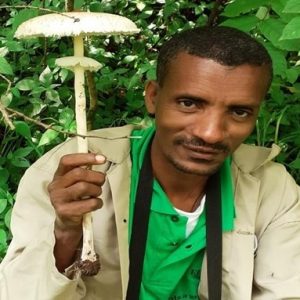Fungal communities associated with forests in the Afromontane region of Ethiopia
| PhD in Conservation and Sustainable use of forest systems |
| Doctor: Demelash Alem Ayana |
| Date of reading: 25/11/2021 |
| Directors: Dr. Pablo Martin-Pinto and Dr. Tatek Dejene Bekele |
| Court: Dr. Wubalem Tadesse Wondifraw (president), Dr. María Leonor Calvo Galván (Secretary), and Dr. José Antonio Bonet Lledós (Member) |
Introduction
 The Afromontane region of Ethiopia has natural and plantation forest systems that provide high socioeconomic and ecological values. However, the natural forests in this region are facing challenges in which their degradation is framed for decades. In response to this, exotic tree species have been introduced to decrease the pressure on the natural forests. Some natural forests have been conserved as priority forests, but without generating tangible benefits for the local community. Fungi/mushrooms are neglected and not included in Ethiopia's forest management plans. Consequently, studies on the effects of forest management on the diversity and composition of fungal communities are very limited.
The Afromontane region of Ethiopia has natural and plantation forest systems that provide high socioeconomic and ecological values. However, the natural forests in this region are facing challenges in which their degradation is framed for decades. In response to this, exotic tree species have been introduced to decrease the pressure on the natural forests. Some natural forests have been conserved as priority forests, but without generating tangible benefits for the local community. Fungi/mushrooms are neglected and not included in Ethiopia's forest management plans. Consequently, studies on the effects of forest management on the diversity and composition of fungal communities are very limited.
Objectives
This study was conducted to generate information on the composition and diversity of the fungal community in the forest systems of the Afromontane region in Ethiopia to assist sustainable forest management in the country.
Development
Materials and methods
The study was conducted in Dry Afromontane Region of Ethiopia. We selected both Pinus patula plantations and Natural forests in Western and Northern Ethiopia. We studied the soil fungal communities in these forests systems. We also surveyed fungal fruit bodies in Natural forests in North Ethiopia. In these studies, the effect of forest fire, stand age, forest types, edaphic variables, climate and vegetation on fungal community composition and diversity were studied by collecting data on permanent sample plots. The molecular and physico-chemical analysis were carried using soil samples collected from each plot. Different sorting techniques and statistical tests were carried out depending on the nature of each study. The effects of above ground vegetation, edaphic and climatic variables on the composition and diversity of the fungal community were also examined.
Result
The study indicated the Afromontane region of Ethiopia harbor great fungal diversity. The soil fungal communities were dominated by Ascomycota and most of them were saprotrophs. Composition and diversity of the fungal community were observed among the different treatment. A higher relative proportion of ectomycorrhizal fungi were recorded in church forests. In the study of fruiting bodies, important ECM species in the general of Tricholoma, Rhizopogon and Suillus were found Also, valuable edible species belonging to the genera Calvatia, Laetiporus, Pleurotus, Termitomyces and Macrolepiota were collected. Also, we have found that the edaphic, spatial, aboveground vegetation and climatic variables as important factors shaping fungal community composition in the studied forest systems.
Conclusions
This study contributes significantly to the knowledge about soil fungal communities in Ethiopia. Also, it provides relevant information required for the management and conservation of the studied forest systems in the Afromontane region of the country. The macrofungi existed also can play a significant role in the management of the forests and provide information for the conservation and optimization of sporocarps production, which can also provide a new source of food for the poor population during food shortage in the rural areas of the country. We recommend that the effect of forest management practices on soil fertility should be taken into consideration owing to the important relationship between these ecological parameters and the soil fungal composition in the dry Afromontane forests of Ethiopia. Promotion of vascular tree diversity in fragmented forest systems by enrichment plantings or assisted natural regeneration management systems would offer suitable habitats with variable microclimates that should assist fungal species. The fragmented church forests are important reservoirs of fungal diversity in Ethiopia and this offers a complementary argument for their conservation and protection. Production of valuable wild mushrooms could be incorporated into management and conservation strategies in these fragmented forest systems.
